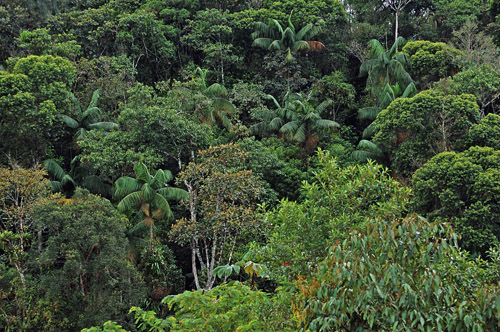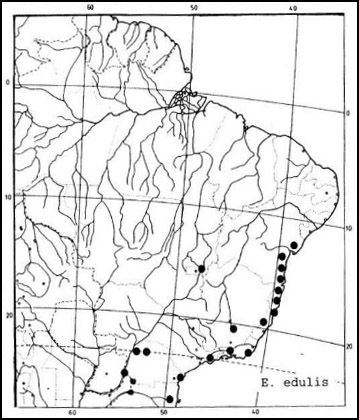|
|
|
|
|
|
|
Taxonomy
|
|
|
|
|
|
|
|
|
|
Kingdom:
|
|
Plantae
|
|
Superdivision:
|
|
Spermatophyta
|
|
Division:
|
|
Magnoliophyta (Angiospermae)
|
|
Class:
|
|
Liliopsida (Monocotyledons)
|
|
Subclass:
|
|
Arecidae
|
|
Order:
|
|
Arecales
|
|
Family:
|
|
Arecaceae (Palmae)
|
|
Subfamily:
|
|
Arecoideae
|
|
Genus:
|
|
Euterpe
|
|
Species:
|
|
Euterpe edulis Martius; Hist. Nat. Palm. 2:33, 1824
|
|
|
|
|
|
|
Botanical synonym
|
|
|
|
|
|
|
Euterpe equsquizae Bertoni ex Hauman, Euterpe globosa Gaertn
|
|
|
|
|
|
Common names
|
|
|
|
|
|
|
|
Açaí-do-sul, ensarova, içara, inçara, iiçara, iuçara, jaçara, jiçara, juçara, palmito, palmeiro-doce; palmiteiro-doce, palmiteiro, palmito-branco, palmito-da-mata, palmito-doce, palmito-juçara, palmito-vermelho, ripa, ripeira
|
|
|
|
|
|
Varieties
|
|
|
|
|
|
|
|
Popularly known are ‘palmito branco’ (white palm), ‘palmito vermelho’ (red palm) and ‘palmito macho’ (male palm). The main difference between the two former is the colour of the leaf sheaths or stem, which is higher and thinner in the ‘red variety’. The so called ‘white palm’ offers a better palm heart quality. Leaves of the so called ‘male palm’ do not drop off and thus the palm heart is always covered by old leaves. Another characteristic of this variety is that no inflorescence, which always occurs in the other varieties, can be observed (MATTOS & MATTOS 1976). In contrast to the latter statement, due to REIS and BABISTE (personal comment), these two forms (male and female palm) are no different varieties but can be attributed to mechanical differences. If the old leaves are cut of from a ‘male palm‘ the plant develops inflorescences and fruits like a ‘female palm‘ plant.
|
|
|
|
|
|
|

|
|
|
|
|
|
|
Typical structure of a sub-montane rainforest in the southern part of the Brazilian Mata Atlântica with a high density of E. edulis
|
|
|
|
|
Origin and geographical distribution
|
|
|
|
|
|
|
|
Within the entire neotropical subtribe Euterpeinae, about 32 species are distributed along the Antilles and
South America
. Thereof 7 are Euterpe (HENDERSON & GALEANO 1996), widely distributed in lowland to montane moist tropical forests. 5 species are found in
Brazil
:
- Euterpe edulis Martius, (Juçara)
- E. catinga Wallace (Açaizinho),
- E. oleracea Martius (Açaí),
- E. longibracteata Barbosa Rodrigues (Açaí-da-Terra-firme) and
- E. precatoria Martius (Açai-da-mata) (HENDERSON 2000).
|
|
|
|
|
|
|
Many species of the genus show a potential for the production of palm heart, but outstanding for palm heart production are E. edulis, with preferential distribution in the
Atlantic
Rain Forest
along the Brazilian coast, and E. oleracea in the low Amazon.
|
|
|
|
|
Distribution of E. edulis in
Brazil
(Source: REIS & REIS 2000)
|
|

|
|
|
|
|
|
|
|
|
Euterpe edulis is a native and endemic palm of the
Brazilian
Atlantic
Rain Forest
. Its area of occurrence extends from the southern
Bahia
(15°S) to the North of Rio Grande do Sul (30°S) with a preferential distribution along the Brazilian coast. Outside of
Brazil
it occurs in the North of Argentina and in eastern
Paraguay
(REIS et al. 1996, LORENZI et al. 2004). The original distribution and abundance of the palm has a high frequency in the medium stratum of the ‘Dense Ombrophilous formation’ and in most parts of the ‘Seasonal deciduous’ and ‘Semi deciduous seasonal formation’ (REIS et al. 2000a). In the mixed ‘Ombrófila formation’ the occurrence of E. edulis is restricted to areas of gallery forests, not exceeding altitudes of 1000 m (HENDERSON 2000).
|
|
|
|
|
|
|
